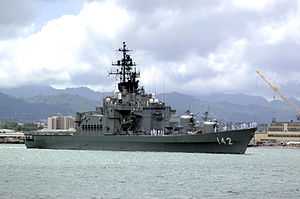Haruna-class destroyer
_passes_Hospital_Point_in_Pearl_Harbor%2C_Hawaii.jpg) Haruna (DDH-141) | |
| Class overview | |
|---|---|
| Name: | Harunaclass |
| Operators: |
|
| Succeeded by: | Shirane class |
| Built: | 1970–1973 |
| In commission: | 1973–2011 |
| Completed: | 2 |
| Retired: | 2 |
| General characteristics | |
| Type: | Destroyer |
| Displacement: | 4,950 long tons (5,029 t) standard 6,900 long tons (7,011 t) full load |
| Length: | 153.1 m (502 ft) |
| Beam: | 17.5 m (57 ft 5 in) |
| Draft: | 5.2 m (17 ft 1 in) |
| Propulsion: | 2 boilers 850 psi (60 kg/cm², 5.9 MPa), 430 °C 2 turbines 2 shafts 60,000 hp (45,000 kW) |
| Speed: | 31 knots (36 mph; 57 km/h) |
| Complement: | 370 360 (DDH-141) 36 officers |
| Armament: | Sea Sparrow Mk.29 SAM octuple launcher ASROC octuple launcher 2 × 5"/54 caliber Mk.42 guns (Type 73) 2 × 20 mm Phalanx CIWS 2 × Mark 32 triple torpedo tubes (Mk-46 torpedoes) |
| Aircraft carried: | 3 × SH-60J(K) anti-submarine helicopters |
The Haruna-class destroyer was a destroyer class built for the Japan Maritime Self-Defense Force (JMSDF) in the early 1970s. These helicopter carrying destroyers (DDH) are built around a large central hangar which houses up to three helicopters.
Originally, the Coastal Safety Force and its successor, the JMSDF, had intended to enable its fleet aviation operating capability. In 1960, the Defense Agency planned to construct one helicopter carrier (CVH) with the Second Defense Build-up Plan, but this project was shelved and finally cancelled because the JMSDF changed their plan to dispersing its fleet aviation assets among destroyers, not concentrating in few helicopter carrier.[1] The Japanese DDH was planned to be a hub with this dispersing fleet aviation concept with their logistics service capability for aircraft.[2]
At the beginning, equipment of this class were similar to those of the Takatsuki-class DDA. All weapons, two 5-inch/54 caliber Mark 42 (Type 73) guns and one Type 74 octuple missile launcher (Japanese version of the American Mark 16 GMLS), were settled on the forecastle deck. But with the Fleet Rehabilitation and Modernization (FRAM) program in 1983 and 1984, Sea Sparrow launchers, Phalanx CIWS systems and chaff launchers were added on the superstructure.[3][4] With this upgrading program, this class became also enable to operate Naval Tactical Data System (NTDS) with OYQ-6/7 combat direction system.[5]
The rear-half of the superstructure was helicopter hangar, and the afterdeck was the helicopter deck with the beartrap system. To operate large HSS-2 ASW helicopters safely, the full length of the helicopter deck reached 50 meters.[5]
Ships in the class
| Pennant no. | Name | Laid down | Launched | Commissioned | Decommissioned | Home port |
|---|---|---|---|---|---|---|
| DDH-141 | Haruna | 19 March 1970 | 1 February 1972 | 22 February 1973 | 18 March 2009 | Maizuru |
| DDH-142 | Hiei | 8 March 1972 | 13 August 1973 | 27 November 1974 | 16 March 2011 | Kure |
Gallery
-
_ship_JS_Haruna_(DDH_141)%2C_USS_Lake_Champlain_(CG_57)_and_USS_Russell_(DDG_59)_steam_in_formation_during_a_photo_exercise_(PHOTOEX)_between_the_Ronald_Reagan_C.jpg)
US Navy 070318-N-5961C-262 Japan Maritime Self Defense Force (JMSDF) ship JS Haruna (DDH-141), USS Lake Champlain (CG-57) and USS Russell (DDG-59) steam in formation during a photo exercise (PHOTOEX) between the Ronald Reagan C
-
.jpg)
JMSDF ship Haruna (DDH-141)
-

JDS Hiei in Pearl Harbor
-

Hiei underway in the Pacific with Ashigara and USS Curtis Wilbur, November 2009
References
- ↑ National Diet Library (1987-05-19). "the record of the proceedings of the budget committee (vol.15)". Retrieved 2012-10-08.
- ↑ "History of Japanese destroyers since 1952". Ships of the World (in Japanese) (Kaijin-sha) (742): 91–97. June 2011.
- ↑ "2. Guns (Shipboard weapons of JMSDF 1952-2010)". Ships of the World (in Japanese) (Kaijin-sha) (721): 88–93. March 2010.
- ↑ Keiichi Nogi (March 2010). "1. Missiles (Shipboard weapons of JMSDF 1952-2010)". Ships of the World (in Japanese) (Kaijin-sha) (721): 82–87.
- ↑ 5.0 5.1 Makoto Yamazaki (October 2011). "Combat systems of modern Japanese destroyers". Ships of the World (in Japanese) (Kaijin-sha) (748): 98–107.
External links
| Wikimedia Commons has media related to Haruna class destroyers. |
| ||||||||||||||
| ||||||||||||||||||||||||||||||||||||||||||||||||||